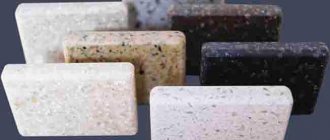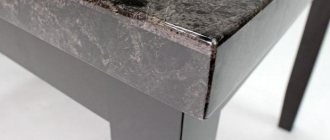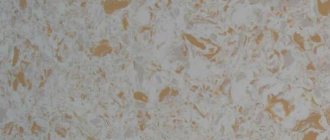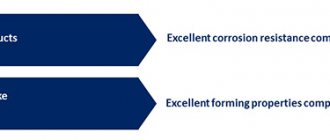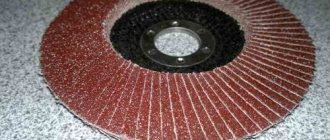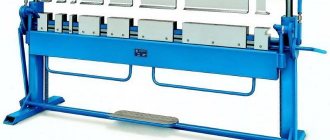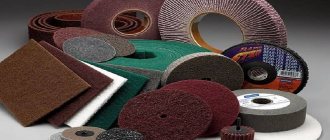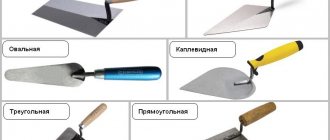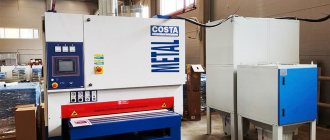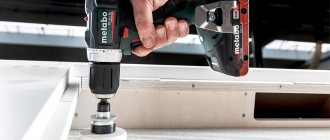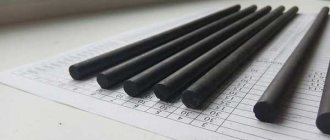Marble, which has excellent decorative properties, has always been valued in construction. But due to the high cost of the material, not everyone can afford to use it to decorate premises. Therefore, an artificial material imitating stone was developed as an alternative. It was called artificial marble.
Description and types of material
Artificial marble is a material that is used primarily in plumbing, in the manufacture of linear and facing materials. It is used to make window sills, bathtubs, countertops, steps, decorative fountains and sculptures. It is used for finishing offices and administrative premises.
The term “artificial marble” refers not only to cast marble, which is an imitation of natural stone. There are other varieties of it that are widely used in construction, industry and interior decoration.
Types of artificial marble:
- injection molding;
- touchstone (or gypsum);
- ground (or crushed);
- flexible (or liquid).
Liteva
The most popular is cast marble - a composite material based on hardened polyester resin and mineral filler. The filler can be marble chips, quartz sand, etc.
Depending on what resins and fillers are chosen, the material can be made as an imitation of natural marble, jasper, granite, malachite, or onyx.
This is what cast artificial marble looks like in the photo
Oselkovy
Touchstone marble is a colored mass of gypsum, sealed with adhesive water, which is applied to the base and brought to a mirror shine by polishing and grinding. It can be tinted to match various materials, such as lapis lazuli, malachite, and different types of marble.
The main material for the production of semolina marble is gypsum. Special substances are added to it that slow down the setting of gypsum. The most commonly used glue is diluted in water.
The advantages of gypsum marble are low weight and high strength. With its help, you can build lightweight structures. The use of this material in residential areas helps improve the microclimate: it absorbs excess moisture or releases it if the room is too dry.
Photo of Oselkov marble
Ground (microcalcite)
Ground or crushed marble is a finely dispersed filler of mineral origin. It is a white or gray powdery substance. It is made by grinding white marble.
This material is characterized by strength, low chemical activity, resistance to ultraviolet rays. It has a bright white color and practically does not absorb moisture. Most often it is used for the production of plastic products, paints and varnishes, abrasive cleaning products, paper, linoleum, etc.
Liquid
This type of marble is one of the newest finishing materials. It consists of marble chips and acrylic polymers.
Liquid marble is very flexible, lightweight and environmentally friendly. It can be easily cut with scissors or a knife and glued to walls instead of wallpaper. Using this material, you can get a perfectly flat, seamless surface. Therefore, it is often used for cladding irregularly shaped structures, such as arches, columns, and spherical objects.
Application of liquid marble
Production of cast artificial marble
The technology for manufacturing the material is quite simple and will only require special equipment, premises, time and financial resources.
Equipment
To produce cast marble, a small set of equipment is used:
- filling molds (matrices);
- gelcoat sprayer;
- mixer for stirring the composition;
- brushes for greasing molds.
Molds for marble production are made on the basis of polyurethane rubber. High-quality matrices, which are characterized by strength and are not prone to severe deformation, are very expensive. However, their cost pays off in full, since production is highly profitable.
Composition of raw materials
To make the material, acrylic or polyester resin and marble chips are mixed in a ratio of 4:1. For bonding, you can also use cement mortar, building gypsum, lime mortar with the addition of cement. But most often it is resins that are used, since they provide high strength to the material.
The filler function is sometimes performed by decorative materials (colored sand, pebbles, colored quartz). In this case, the finished products are not an analogue of natural stone, but a fundamentally new type of finishing materials.
To achieve the required color, mineral pigments are introduced into the mixture. The material is made in different colors, with inclusions and streaks. For this purpose, a special technique for mixing pigments is used. Pigments not only color the material, but also make it more resistant to external influences. The outer protective layer of gelcoat gives the coating a glossy shine.
Production technology
The technology for manufacturing the material is very simple and not labor-intensive. It involves preparing the matrix, mixing the polyester resin and filler, pouring the resulting mixture into the matrix and curing it.
The artificial marble casting process can be divided into the following stages:
- The molds are polished and a material is applied to prevent adhesion.
- Gelcoat is applied to the molds. For this purpose, a special installation or cup sprayer is used.
- The gelcoat is curing.
- A mixture of polyester resin, filler, pigments and hardener is prepared.
- The mixture is poured into molds.
- The molds are vibrated to remove air from the mixture.
- The material is curing.
- The products are removed from the molds.
- Further processing of the material is carried out (in some cases).
In the video, the production of cast marble and sinks from it:
Preparatory work
Molds for making artificial marble can be either purchased or made yourself
The easiest way to make artificial marble is from cement and sand. If the technology is followed, in this case the products retain all their properties. The main thing is not to make slabs that are too thin or thick. The former turn out to be fragile, while the latter are heavy.
To make artificial marble you will need:
- fine sand;
- cement grade 500;
- plasticizer S-3 (it improves the technical characteristics of concrete);
- pigment - an inorganic dye that does not dissolve in water, for example, oil paint;
- filler - quartz sand, marble chips, dolomite, limestone or pebbles;
- polyethylene film;
- water.
To work, you need to prepare in advance:
- container for preparing the solution;
- construction mixer with an attachment or a hammer drill with a mixing attachment;
- polymer form - you can purchase it or make it yourself from polyurethane, gypsum or plastic. They can be replaced with a wooden frame with glass placed at the bottom;
When choosing a mold, it is important to ensure that its surface is even and smooth, and that it itself is detachable. In this case, you can easily get the finished product.
- vibrating table - it is indispensable in the production of artificial marble in large quantities. Regardless of the type of vibration - horizontal or vertical, it helps remove air bubbles from the solution and compact it. In the absence of such a design, you can simply shake the form vigorously constantly;
- brushes for greasing the mold;
- gelcoat sprayer;
- grinding machine with diamond disc cups for processing the finished slab.
DIY cast marble
It is quite possible to make artificial cast marble yourself. You just need to purchase all the components of the material, molds for pouring and follow the instructions.
To make cast marble you will need:
- polyurethane casting mold;
- film;
- mixer;
- brush.
In production, the filler is CaMg(CO3)2, and the hardener is Butanox M-50. At home, pebbles and cement can be used instead of these substances.
Materials for making artificial marble:
- sand (river) – 2 parts;
- cement – 1 part;
- water – 0.2 parts;
- pebbles (as filler) – 25% of the total volume;
- pigment – 1% by weight of cement;
- plasticizer – 1% by weight of cement;
- gelcoat
Sequence of production of cast marble:
- A dry and clean mold is coated with gelcoat and allowed to dry.
- Mix sand, pebbles and cement. Add a plasticizer, coloring pigment and water (80%) to the mixture, mix with a mixer to obtain a plastic mass (about 30 seconds). Then add the rest of the water and stir the mixture again until smooth.
- The mixture is poured into a mold, excess is removed from the edges, covered with film and left to harden for 10 hours.
- The material is removed from the mold and left in the open air for some time.
In this simple way, you can obtain a material that can be used in its original form or subjected to further processing to give the desired shape.
The technology for self-production of artificial cast marble is shown in the video below:
Pros and cons, reviews
Although the composition of artificial marble is fundamentally different from its natural counterpart, it has the same technical properties. Moreover, the level of strength and wear resistance of artificially produced material is several times higher than that of natural material.
The main advantages of artificial marble:
- has a high level of mechanical strength and is not afraid of impacts;
- is durable and has a long service life;
- almost does not conduct heat and electricity, has a high level of fire safety. Therefore, it can be used to decorate heating radiators, electric stoves, etc.;
- the material does not heat up, does not delaminate, is not afraid of acids, alkalis, solvents, does not absorb fat, and does not leave stains on it. Due to this practicality, it is often used to decorate kitchens and bathrooms, and finish floors in residential, industrial and public spaces;
- does not emit harmful substances, is environmentally friendly;
- Thanks to the external gelcoat coating, it looks aesthetically pleasing and can be used for decorative purposes.
It combines the hardness of natural stone and ease of processing. Unlike natural marble, artificial material provides a greater degree of comfort and is always warm to the touch.
Among the disadvantages of artificial stone, many note that it cannot be considered a complete analogue of natural material. It feels more like plastic, and the top coating looks like polyurethane.
In addition, the gel coating often cracks over time. As a result, the material becomes discolored and destroyed.
Reviews
Irena Thor · 13 days ago
Pros: Very high quality work
Disadvantages: No
Comment: Today master Alexander made our bath white and sparkling, he is a professional in his field, answered all my questions and did his job efficiently, thank him for that! I will recommend it to my loved ones...
Bathroom restoration reviews - 2022 | "MosAcryl"
Tatyana_D · 22 days ago
Comment: In February last year, the bathroom was restored, but a year later a crack appeared in the area of the drain. They called a repairman under warranty, and a day later he came and fixed everything. Thank you …
Bathroom restoration reviews - 2022 | "MosAcryl"
Olga · 1 month ago
Comment: Everything was great, we arrived even early, but we asked in advance if I could accept, which is important. They even brought a newspaper with them and laid it out very carefully. I'm in the process...
Bathroom restoration reviews - 2022 | "MosAcryl"
Read all reviews
Average cost of artificial marble
The marble manufacturing process involves minimal investment and very high profitability. Initially, costs are incurred for the purchase of equipment, raw materials, rent of premises and production of matrices. In the future, the cost of products is determined mainly by the cost of raw materials.
The production cost is estimated at approximately $5 per 1 sq. m. m., while the market price reaches $30 per 1 sq. m. m. or even higher.
Various products and materials made from artificial marble are considered to be just as beautiful, strong and durable as products made from real natural stone. After all, its production has been improved over the course of 30 years and achieved high results.
Product molds
Much in the quality of the implementation of the technological process depends on the equipment used, the main element of which is the mentioned form, that is, the matrix. There is ready-made equipment on the market, but in most cases, manufacturers purchase matrices on special order. The fact is that molds for cast marble determine what the final product will be like. Therefore, we are not talking about standards for the execution of such equipment - each manufacturer strives to make its products unique, therefore, the sketches of the matrices are developed as copyright ones with unique sizes and textures. Another thing is that in each case high demands are placed on the material used to make the molds. Usually a composite material is used, similar in characteristics to plastic, but, of course, much stronger and more durable.
